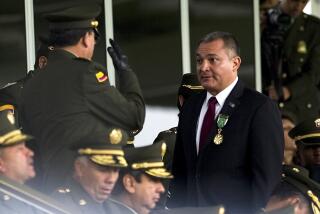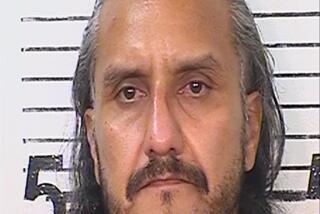Mexican Mafia Figure Convicted of 3 Murders
A Mexican Mafia leader was convicted Wednesday of murdering three men and ordering hits on eight others in the first death penalty case tried in Los Angeles federal court in half a century.
The verdict, reached after 26 days of jury deliberations, sets the stage for penalty proceedings in which Mariano “Chuy” Martinez, a 42-year-old father of two, could be sentenced to death or to life without parole.
Members of Martinez’s family sobbed softly as a court clerk read the jury’s verdicts, convicting him on 24 of 25 criminal counts, including racketeering, murder, conspiracy to murder, assault with a dangerous weapon and drug trafficking.
U.S. District Judge David O. Carter ordered the jury to return next Wednesday, when the penalty phase will begin. The jury’s decision is binding on the judge.
Prosecutors and defense lawyers declined comment on Wednesday’s verdicts. Both sides said they will have nothing to say until after the penalty trial.
Martinez, a stocky man with a bushy mustache, was one of 43 reputed Mexican Mafia members and associates indicted by a grand jury in 1999. Federal prosecutors have charged nine other defendants with capital crimes.
Prosecutors described Martinez as the highest-ranking Mexican Mafia leader in the Los Angeles area, and said he took orders directly from the gang’s so-called godfather, Benjamin Peters, who is serving a life sentence at Pelican Bay State Prison in Northern California.
The Mexican Mafia, also known as La Eme, was founded during the late 1950s by a group of inmates from East Los Angeles in an attempt to control drug trafficking behind prison walls.
Over the years, authorities say, La Eme extended its reach throughout the prison system and into the streets of Southern and Central California, extorting “taxes” from neighborhood gangs engaged in small-time drug dealing.
Although Martinez was the ranking Mexican Mafia leader in Los Angeles, he faced a challenge to his authority from another high-level gang member, John Turscak.
Bitter and sometimes violent warfare erupted between the two sides in 1997. Martinez survived two murder attempts by Turscak’s crew, according to trial testimony.
In November 1998, prosecutors said, Richard Serrano, a reputed drug dealer and close associate of Turscak, was spotted in an auto body shop on Olympic Boulevard in Montebello.
After being notified, Martinez got on the phone and directed his men to go there and kill Serrano along with any witnesses, Assistant U.S. Attys. Daniel Levin and Susan Barna told the jury.
Martinez’s chief lieutenant, Max Torvisco, testified that his former mentor personally orchestrated the murders of Serrano and two innocent bystanders from a nearby location, using a two-way radio.
The defendant did not testify, but his lawyers denounced Torvisco as a liar who concocted the story to save his own neck. Torvisco, a onetime student at Cal State L.A., acknowledged having ordered as many as 140 killings while a Mexican Mafia member. He negotiated a still-secret plea deal with the government after his arrest.
While denying his involvement in the Montebello murders, Martinez’s court-appointed attorneys, Mark Overland and Neison Marks, conceded that their client may have been involved in other acts of violence detailed in the indictment. But they insisted that he was acting to defend himself from repeated murder attempts.
They sought to portray him as a man who eschewed violence, arguing that as a Mexican Mafia leader he had tried to force Latino street gangs to put aside their turf battles in the interest of neighborhood peace. At one point, they said, Martinez threatened to punish any street gang member who killed an innocent bystander in a drive-by shooting.
The prosecution’s case was built largely around nearly 400 secretly recorded telephone conversations. In many of them, Martinez talked with his close supporters about strategy, enemies and punishments, known in Mexican Mafia lingo as “green lights.”
Martinez also talked about his “peace program” to end gratuitous street violence. But prosecutors described it as disingenuous. They said he wanted the neighborhood gangs to suspend their wars so they could focus their energies on selling narcotics, generating more money for La Eme.
Not since 1950 has a death penalty case been tried in Los Angeles federal court. In that year, Tomoya Kawakita was sentenced to die after being convicted of treason for beating and torturing American prisoners of war who were forced to work in Japanese munitions plants during World War II. The sentence was never carried out, and years later Kawakita was pardoned.
More to Read
Sign up for Essential California
The most important California stories and recommendations in your inbox every morning.
You may occasionally receive promotional content from the Los Angeles Times.










